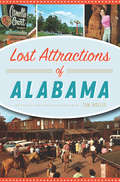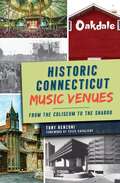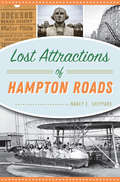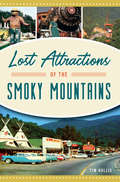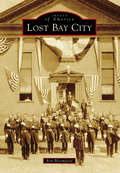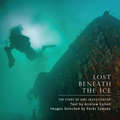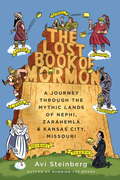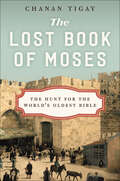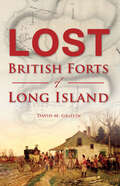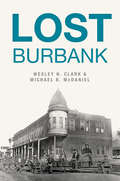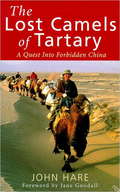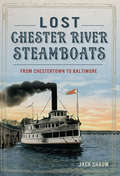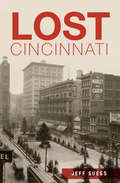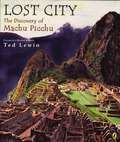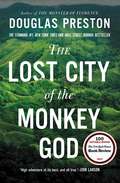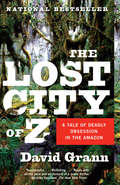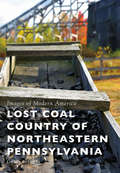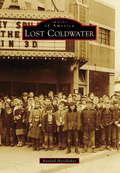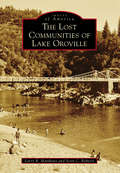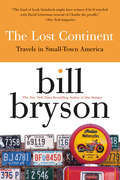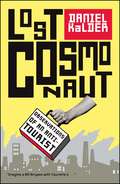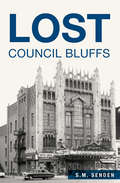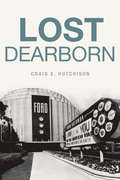- Table View
- List View
Lost Attractions of Alabama
by Tim HollisAlabama has had an enviable success rate when it comes to tourist attractions, with some that date back to the 1930s still drawing crowds today. But many others have come and gone, sometimes leaving little evidence of their existence. Join Alabama native Tim Hollis as he revisits iconic attractions such as Canyon Land Park and Sequoyah Caverns, the floral clock at Birmingham's Botanical Gardens and the traffic safety torch held aloft by Vulcan, the iron man. Many Gulf Coast attractions are gone, including Styx River Water World and Spooky Golf, but the memories remain.
Lost Attractions of Florida's Miracle Strip (Lost)
by Tim HollisBeginning in the early 1950s, the 130 miles of Florida coastline stretching from Panama City to Pensacola were branded as the Miracle Strip. Between those cities, oddities sprang up: goofy miniature golf courses, neon-bedecked motels, reptile farms and attractions that sought to re-create environments ranging from the South Pacific to the ghost towns of the Old West. In total, it was a marketing effort that worked brilliantly. Tourists flocked to the Strip, and now they can return. Author Tim Hollis presents a colorful array of these now-vanished sights, from the garish Miracle Strip Amusement Park to such oddities as Castle Dracula and the Museum of the Sea and Indian.
Lost Attractions of Hampton Roads (Lost)
by Nancy E. SheppardTake a trip down memory lane to beloved destinations for fun and families across Virginia's tidewater. Cruise the rails of Ocean View Amusement Park's "The Rocket" roller coaster, dig for fossils at Hampton's Rice's Fossil Pit, celebrate the winter season at Portsmouth's Coleman's Nursery and learn the significant role that Buckroe Beach's Bay Shore Beach Park played in American history. From the Great White Fleet to a Wild West park, journey through this vibrant history with author and historian Nancy E. Sheppard and discover whether such cherished places can ever truly be lost.
Lost Attractions of the Smoky Mountains (Lost)
by Tim HollisThe Great Smoky Mountains National Park is among the most visited national parks in the country, and countless attractions around its borders have tried for decades to siphon some of those valuable tourist dollars. From ersatz western towns and concrete dinosaurs to misplaced Florida-type attractions and celebrity theaters, you will find them all preserved in this book. Author Tim Hollis showcases those businesses that no longer exist, from Hill-Billy Village in Pigeon Forge and Gatlinburg's theme parks on the Tennessee side to the motels of Cherokee and Ghost Town in the Sky on the North Carolina side.
Lost Bay City
by Ron BloomfieldWhen the phrase "Do you remember?" is uttered in Bay City, it is usually followed by the name of a hotel, restaurant, business, or building. Slowly, many parts of local history have been lost to the sands of time. Fire took many, followed by condemnations and the inevitable advance of progress. An empty lot may be all that remains of a once-prominent structure, but sometimes a new landmark emerges. In the case of one famous address at Center and Water Streets, the Wenonah Hotel rose out of the ashes of the Fraser House, another prominent facade. Seven decades later, the Wenonah, too, succumbed to fire; out of those ashes rose the Delta College Planetarium, a third-generation landmark. Photographs help residents remember, though each person who experienced something firsthand has his or her own distinct connection with these pieces of lost Bay City.
Lost Beneath the Ice: The Story of HMS Investigator
by Andrew CohenThe story of the bold voyage of HMS Investigator and the modern-day discovery of its wreck by Parks Canada’s underwater archaeologists. When Sir John Franklin disappeared in the Arctic in the 1840s, the British Admiralty launched the largest rescue mission in its history. Among the search vessels was HMS Investigator, which left England in 1850 under the command of Captain Robert McClure. While the ambitious McClure never found Franklin, he and his crew did discover the fabled Northwest Passage. Like Franklin’s ships, though, Investigator disappeared in the most remote, bleak and unknown place on Earth. For three winters, its 66 souls were trapped in the unforgiving ice of Mercy Bay. They suffered cold, darkness, starvation, scurvy, boredom, depression and madness. When they were rescued in 1853, Investigator was abandoned. For more than a century and a half, the ship’s fate remained a mystery. Had it been crushed by the ice or swept out to sea? In 2010, Parks Canada sent a team of archaeologists to Mercy Bay to find out. It was a formidable challenge, demanding expertise and patience. There, off the shores of Aulavik National Park, they found Investigator. Lost Beneath the Ice is a tale of endurance, daring, deceit, courage, and irony. It is a story about a tempestuous crew, their mercurial captain, cynical surgeon and kind-hearted missionary. In the end, McClure found fame but lost his ship, some of his crew and much of his honour. Written with elegance and authority, illustrated with archival imagery and startling underwater photographs of Investigator and its artifacts, this is a sensational story of discovery and intrigue in Canada’s Arctic. Andrew Cohen is a best-selling author and award-winning journalist. Among his books are While Canada Slept, a finalist for the Governor General’s Literary Award, The Unfinished Canadian, and Extraordinary Canadians: Lester B. Pearson. He writes a nationally syndicated column for The Ottawa Citizen and comments regularly on CTV. A professor of journalism and international affairs at Carleton University, he is founding president of the Historica-Dominion Institute. He has twice received Queen’s Jubilee Medals.
The Lost Book of Mormon
by Avi SteinbergIs the Book of Mormon the Great American Novel? Decades before Melville and Twain composed their great works, a farmhand and child seer named Joseph Smith unearthed a long-buried book from a haunted hill in western New York State that told of an epic history of ancient America, a story about a family that fled biblical Jerusalem and took a boat to the New World. Using his prophetic gift, Joseph translated the mysterious book into English and published it under the title The Book of Mormon. The book caused an immediate sensation, sparking anger and violence, boycotts and jealousy, curiosity and wonder, and launched Joseph on a wild, decades-long adventure across the American West. Today The Book of Mormon, one of the most widely circulating works of American literature, continues to cause controversy--which is why most of us know very little about the story it tells. Avi Steinberg wants to change that. A fascinated nonbeliever, Steinberg spent a year and a half on a personal quest, traveling the path laid out by Joseph's epic. Starting in Jerusalem, where The Book of Mormon opens with a bloody murder, Steinberg continued to the ruined Maya cities of Central America--the setting for most of the The Book of Mormon's ancient story--where he gallivanted with a boisterous bus tour of believers exploring Maya archaeological sites for evidence. From there the journey took him to upstate New York, where he participated in the true Book of Mormon musical, the annual Hill Cumorah Pageant. And finally Steinberg arrived at the center of the American continent, Jackson County, Missouri, the spot Smith identified as none other than the site of the Garden of Eden.Threaded through this quirky travelogue is an argument for taking The Book of Mormon seriously as a work of American imagination. Literate and funny, personal and provocative, the genre-bending The Lost Book of Mormon boldly explores our deeply human impulse to write bibles and discovers the abiding power of story.From the Hardcover edition. about us. And also an answer to the question: Why are we so afraid of the Book of Mormon? Literate and funny, personal and provocative, the genre-bending Lost Book of Mormon boldly explores our deeply human impulse to write bibles and discovers the abiding power of story.
The Lost Book of Moses: The Hunt for the World's Oldest Bible
by Chanan TigayOne man’s quest to find the oldest Bible scrolls in the world and uncover the story of the brilliant, doomed antiquarian accused of forging them.In the summer of 1883, Moses Wilhelm Shapira—archaeological treasure hunter and inveterate social climber—showed up unannounced in London claiming to have discovered the oldest copy of the Bible in the world.But before the museum could pony up his £1 million asking price for the scrolls—which discovery called into question the divine authorship of the scriptures—Shapira’s nemesis, the French archaeologist Charles Clermont-Ganneau, denounced the manuscripts, turning the public against him. Distraught over this humiliating public rebuke, Shapira fled to the Netherlands and committed suicide.Then, in 1947 the Dead Sea Scrolls were discovered. Noting the similarities between these and Shapira’s scrolls, scholars made efforts to re-examine Shapira’s case, but it was too late: the primary piece of evidence, the parchment scrolls themselves had mysteriously vanished.Tigay, journalist and son of a renowned Biblical scholar, was galvanized by this peculiar story and this indecipherable man, and became determined to find the scrolls. He sets out on a quest that takes him to Australia, England, Holland, Germany where he meets Shapira’s still aggrieved descendants and Jerusalem where Shapira is still referred to in the present tense as a “Naughty boy”. He wades into museum storerooms, musty English attics, and even the Jordanian gorge where the scrolls were said to have been found all in a tireless effort to uncover the truth about the scrolls and about Shapira, himself.At once historical drama and modern-day mystery, The Lost Book of Moses explores the nineteenth-century disappearance of Shapira’s scrolls and Tigay's globetrotting hunt for the ancient manuscript. As it follows Tigay’s trail to the truth, the book brings to light a flamboyant, romantic, devious, and ultimately tragic personality in a story that vibrates with the suspense of a classic detective tale.
Lost British Forts of Long Island (Lost Ser.)
by David M GriffinAuthor David M. Griffin uncovers the lost history and harrowing stories of Long Island's British forts.When the Revolutionary War broke out and New York City had fallen in 1776, the forces of the king of Great Britain developed a network of forts along the length of Long Island to defend the New York area and create a front to Patriot forces across the Sound in Connecticut. Fort Franklin on Lloyd's Neck became a refugee camp for Loyalists and saw frequent rebel attacks. In Huntington, a sacred burial ground was desecrated, and Fort Golgotha was erected in its place, using tombstones as baking hearths. In Setauket along the northern shore, the Presbyterian church was commandeered and made the central fortified structure of the town.
Lost Burbank (Lost)
by Wesley H. Clark Michael B. McdanielSlowly fading with the city's ever-changing landscape, the places and people of Burbank's past tell a vibrant story. Before the arrival of Warner Bros. and Walt Disney, First National Pictures built its original studio lot on Olive Avenue in 1926. For over sixty years, Lockheed Aircraft Company produced some of the nation's best airplanes where the massive Empire Shopping Center now stands. Heavyweight champion James Jeffries turned his Burbank ranch home and barn into a beloved landmark and boxing venue. And inventor Joseph Wesley Fawkes's scheme to build a monorail to Los Angeles became a local laughingstock. Die-hard Burbankers Wes Clark and Michael McDaniel collect these and many more forgotten local stories where they can finally be found.
The Lost Camels Of Tartary: A Quest into Forbidden China
by John HareJohn Hare has made three expeditions to the Mongolian and Chinese Gobi deserts, the first in 1993 with Russian scientists and the second and third with Chinese scientists in 1995 and 1996. The book records the amazing adventures he has experienced on those expeditions and will record details of the 30-day walk on foot in the formidable Kum Tagh sand dunes in the spring of 1997. He is the first recorded foreigner to have crossed the Gashun Gobi from north to south. The expeditions were primarily concerned with tracking down the mysterious wild Bactrian camel 'camelus bactrianus ferus' which lives in the heartland of the desert and is the ancestor of all domestic Bactrian stock. There are under a thousand left in the world and the wild Bactrian camel is more endangered than the giant Panda. This is John Hare's magnificent account of a formidable feat of modern exploration.
The Lost Camels Of Tartary: A Quest into Forbidden China
by John HareJohn Hare has made three expeditions to the Mongolian and Chinese Gobi deserts, the first in 1993 with Russian scientists and the second and third with Chinese scientists in 1995 and 1996. The book records the amazing adventures he has experienced on those expeditions and will record details of the 30-day walk on foot in the formidable Kum Tagh sand dunes in the spring of 1997. He is the first recorded foreigner to have crossed the Gashun Gobi from north to south. The expeditions were primarily concerned with tracking down the mysterious wild Bactrian camel 'camelus bactrianus ferus' which lives in the heartland of the desert and is the ancestor of all domestic Bactrian stock. There are under a thousand left in the world and the wild Bactrian camel is more endangered than the giant Panda. This is John Hare's magnificent account of a formidable feat of modern exploration.
Lost Chester River Steamboats: From Chestertown to Baltimore (Transportation)
by Jack ShaumIn the golden age of the steamer, the rich bounty of the Eastern Shore was transported down the Chester River and across the Chesapeake Bay to the port of Baltimore. For over one hundred years, vessels like the Maryland, the Chester and the B.S. Ford traversed these winding waters laden with fruit, grains, crabs and oysters. For a dollar, passengers could enjoy the novelty of a ride and the slow panorama of the shoreline. Through freeze and fog, skilled captains plied the waterways until the last of the steamers--the Bay Belle--made its final passage in the 1950s. Author and historian Jack Shaum journeys back to the bygone days of the Chester River's steamboats.
Lost Cincinnati (Lost)
by Jeff SuessCincinnati earned its nickname of "Queen City of the West" with a wealth of fine theaters and hotels, a burgeoning brewery district and the birth of professional baseball. Though many of these treasures have vanished, they left an indelible mark on the city. Revisit the favorite locales from old Coney Island to Crosley Field. Celebrate lost gems, such as the palatial Albee Theater and the historic Burnet House, where Generals Grant and Sherman plotted the end of the Civil War. Along the way, author Jeff Suess uncovers some uniquely Cincinnati quirks from the inclines and the canal to the infamous incomplete subway. Join Suess as he delves into the mystery and legacy of Cincinnati's lost landmarks.
Lost City: The Discovery of Machu Picchu
by Ted LewinCaldecott Honor-winner Ted Lewin takes readers on a thrilling journey to the wilds of Peru in this story of Hiram Bingham, who, in 1911, carved a treacherous path through snake-filled jungles and across perilous mountains in search of Vilcapampa, the lost city of the Incas. Guided the last steps by a young Quechua boy, however, he discovered not the rumored lost city, but the ruins of Machu Picchu, a city totally unknown to the outside world, and one of the wonders of the world.
The Lost City of the Monkey God: A True Story
by Douglas Preston<P>A five-hundred-year-old legend. An ancient curse. A stunning medical mystery. And a pioneering journey into the unknown heart of the world's densest jungle. <P>Since the days of conquistador Hernán Cortés, rumors have circulated about a lost city of immense wealth hidden somewhere in the Honduran interior, called the White City or the Lost City of the Monkey God. Indigenous tribes speak of ancestors who fled there to escape the Spanish invaders, and they warn that anyone who enters this sacred city will fall ill and die. In 1940, swashbuckling journalist Theodore Morde returned from the rainforest with hundreds of artifacts and an electrifying story of having found the Lost City of the Monkey God-but then committed suicide without revealing its location. <P>Three quarters of a century later, bestselling author Doug Preston joined a team of scientists on a groundbreaking new quest. In 2012 he climbed aboard a rickety, single-engine plane carrying the machine that would change everything: lidar, a highly advanced, classified technology that could map the terrain under the densest rainforest canopy. In an unexplored valley ringed by steep mountains, that flight revealed the unmistakable image of a sprawling metropolis, tantalizing evidence of not just an undiscovered city but an enigmatic, lost civilization. <P>Venturing into this raw, treacherous, but breathtakingly beautiful wilderness to confirm the discovery, Preston and the team battled torrential rains, quickmud, disease-carrying insects, jaguars, and deadly snakes. But it wasn't until they returned that tragedy struck: Preston and others found they had contracted in the ruins a horrifying, sometimes lethal-and incurable-disease. <P>Suspenseful and shocking, filled with colorful history, hair-raising adventure, and dramatic twists of fortune, THE LOST CITY OF THE MONKEY GOD is the absolutely true, eyewitness account of one of the great discoveries of the twenty-first century. <P><b>A New York Times Bestseller</b>
The Lost City of Z: A Tale of Deadly Obsession in the Amazon (Vintage Departures Ser.)
by David GrannThis New York Times bestseller is soon to be a major motion picture starring Charlie Hunnam, Tom Holland, and Robert Pattinson and directed by James Gray. In 1925, the legendary British explorer Percy Fawcett ventured into the Amazon jungle, in search of a fabled civilization. He never returned. Over the years countless perished trying to find evidence of his party and the place he called “The Lost City of Z.” In this masterpiece of narrative nonfiction, journalist David Grann interweaves the spellbinding stories of Fawcett’s quest for “Z” and his own journey into the deadly jungle, as he unravels the greatest exploration mystery of the twentieth century.Look for David Grann’s new book, Killers of the Flower Moon, coming April 18, 2017.
Lost Coal Country of Northeastern Pennsylvania (Images of Modern America)
by Lorena BeniquezLost Coal Country of Northeastern Pennsylvania documents the region’s disappearing anthracite history, which shaped the legacy of the United States of America and the industrial revolution. The coal mines, breakers, coal miners’ homes, and railroads have all steadily disappeared. With only one coal breaker left in the entire state, it was time to record what would soon be lost. Unfortunately, one piece of history that persists is underground fires that ravage communities like Centralia. Blazing for over 50 years, the flames of Centralia will not be doused anytime soon. Images featured in the book include the St. Nicholas coal breaker, Huber coal breaker, Steamtown National Historic Site, Lackawanna Coal Mine Tour, Eckley Miners’ Village, Centralia, and the Knox Mine disaster. A hybrid history book and travel guide, Lost Coal Country of Northeastern Pennsylvania is one final recounting of what is gone and what still remains.
Lost Coldwater
by Randall HazelbakerIn 1831, Rev. Allen Tibbits and Joseph Hanchett arrived in the area that would become Coldwater. Together, they platted out a village and named it Lyons after their hometown in New York. Potawatomi Indians called the area "chuck-sey-ya-bish," which translated to "cold water," and within two years the settlers followed the Indians' example in naming the village. Many pioneers traveled on the Historic Sauk Trail (now US Route 12), which connects Detroit to Chicago, putting Coldwater on the map. The introduction of the Erie Canal in 1825--and railroad transit in 1850--revolutionized travel and spawned rapid growth. By 1861, Coldwater was recognized as a city. As a result of this growth, cottages at Coldwater Lake started showing up in the late 1870s as "summer getaways," enticing tourists to the area. In addition, cultural outlets like the Tibbits Opera House, built in 1882 and boasting Second Empire architecture, graced the downtown area.
The Lost Communities of Lake Oroville (Images of America)
by Larry R. Matthews Scott C. RobertsIn 1968, Lake Oroville flooded the West Branch, North Fork, Middle Fork, and South Fork canyons of the Feather River. Also inundated were the communities of Las Plumas, the Big Bend Power House, Bidwell Bar, and Enterprise. In 1994, Feather Falls Village, located above the lake, also ceased to exist due to a totally different situation. But all of these communities had one thing in common: there were people who had resided in them for decades and who still have an emotional connection to them. This book attempts to preserve some of the history of those areas and also tries to show some of what it was like to live in those now almost forgotten communities.
The Lost Continent
by Bill BrysonAn unsparing and hilarious account of one man's rediscovery of America and his search for the perfect small town.
The Lost Continent: Travels in Small-Town America
by Bill BrysonFrom the Publisher: An unsparing and hilarious account of one man's rediscovery of America and his search for the perfect small town.
Lost Cosmonaut: Observations of an Anti-Tourist
by Daniel KalderDaniel Kalder belongs to a unique group: the anti-tourists. Sworn to uphold the mysterious tenets ofThe Shymkent Declarations, the anti-tourist seeks out the dark, lost zones of our planet, eschewing comfort, embracing hunger and hallucinations, and always traveling at the wrong time of year. In Lost Cosmonaut, Kalder visits locations that most of us don't even know exist -- Tatarstan, Kalmykia, Mari El, and Udmurtia. He loves these places because no one else does, because everyone else passes them by. A tale of adventure, conversation, boredom, and observation -- occasionally enhanced by an overactive imagination -- Kalder reveals a world of hidden cities, lost rites, mail-order brides, machine guns, mutants, and cold, cold emptiness. In the desert wastelands of Kalmykia, he stumbles upon New Vasyuki, the only city in the world dedicated to chess. In Mari El, home to Europe's last pagan nation, he meets the chief Druid and participates in an ancient rite; while in the bleak industrial badlands of Udmurtia, Kalder searches for Mikhail Kalashnikov, inventor of the AK-47, and inadvertently becomes a TV star. An unorthodox mix of extraordinary stories woven together with fascinating history, peculiar places, and even stranger people,Lost Cosmonautis poetic and profane, hilarious and yet oddly heartwarming, bizarre and even educational. In short, it's the perfect guide to the most alien planet in our cosmos: Earth.
Lost Council Bluffs (Lost)
by S. M. SendenNestled in the Loess Hills, Council Bluffs grew from a frontier settlement of wickiups and log cabins. The outpost boomed as a gateway to the West when gold was discovered in California in 1849. The Pacific House and the Ogden House became landmark hotels for the transient population. Meanwhile, residents thrived and cultivated a bustling city with the Masonic Hall, Dohany's Opera House and the Merriam block. None of these once iconic buildings remains today. Author S.M. Senden explores the perpetual rebirth of Council Bluffs through its most important buildings and relates a still unfolding story.
Lost Dearborn (Lost)
by Craig E. HutchisonThroughout its existence, Dearborn has been a pioneer settlement, a multicultural hub, a college town, a major tourism center and a world-renowned industrial city. Unfortunately, due to a variety of factors, significant structures have been lost to time. Almost all of the eleven U.S. Arsenal complex buildings have disappeared since the arsenal was closed in 1875. The hallways of the Edison School and Oxford School still live on in the hearts of their students but were razed long ago. Even beloved edifices such as the Ford Rotunda and the Ford Motor Company Administration building, built by Dearborn's favorite son, Henry Ford, are now only a memory. Author Craig E. Hutchison endeavors to immortalize the important foundational building blocks of an evolving city.
